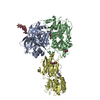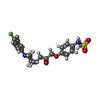Entry Database : PDB / ID : 8g18Title Heterodimer of the GluN1b-GluN2B NMDA receptor amino-terminal domains bound to allosteric inhibitor 93-108 (Glutamate receptor ionotropic, NMDA ...) x 2 Keywords / / / / / Function / homology Function Domain/homology Component
/ / / / / / / / / / / / / / / / / / / / / / / / / / / / / / / / / / / / / / / / / / / / / / / / / / / / / / / / / / / / / / / / / / / / / / / / / / / / / / / / / / / / / / / / / / / / / / / / / / / / / / / / / / / / / / / / / / / / / / / / / / / / / / / / / / / Biological species Xenopus laevis (African clawed frog)Rattus norvegicus (Norway rat)Method / / / Resolution : 2.85 Å Authors Regan, M.C. / Furukawa, H. Funding support Organization Grant number Country National Institutes of Health/National Institute of Mental Health (NIH/NIMH) MH085926 National Institutes of Health/National Institute of Neurological Disorders and Stroke (NIH/NINDS) NS113632
Journal : Acs Chem Neurosci / Year : 2023Title : Novel GluN2B-Selective NMDA Receptor Negative Allosteric Modulator Possesses Intrinsic Analgesic Properties and Enhances Analgesia of Morphine in a Rodent Tail Flick Pain Model.Authors : Harris, L.D. / Regan, M.C. / Myers, S.J. / Nocilla, K.A. / Akins, N.S. / Tahirovic, Y.A. / Wilson, L.J. / Dingledine, R. / Furukawa, H. / Traynelis, S.F. / Liotta, D.C. History Deposition Feb 1, 2023 Deposition site / Processing site Revision 1.0 Mar 1, 2023 Provider / Type Revision 1.1 Mar 15, 2023 Group / Category / citation_authorItem _citation.journal_volume / _citation.page_first ... _citation.journal_volume / _citation.page_first / _citation.page_last / _citation_author.identifier_ORCID Revision 1.2 Oct 25, 2023 Group / Refinement descriptionCategory / chem_comp_bond / pdbx_initial_refinement_modelItem Revision 1.3 Oct 30, 2024 Group / Category / pdbx_modification_feature / Item
Show all Show less
 Yorodumi
Yorodumi Open data
Open data Basic information
Basic information Components
Components Keywords
Keywords Function and homology information
Function and homology information
 X-RAY DIFFRACTION /
X-RAY DIFFRACTION /  SYNCHROTRON /
SYNCHROTRON /  MOLECULAR REPLACEMENT / Resolution: 2.85 Å
MOLECULAR REPLACEMENT / Resolution: 2.85 Å  Authors
Authors United States, 2items
United States, 2items  Citation
Citation Journal: Acs Chem Neurosci / Year: 2023
Journal: Acs Chem Neurosci / Year: 2023 Structure visualization
Structure visualization Molmil
Molmil Jmol/JSmol
Jmol/JSmol Downloads & links
Downloads & links Download
Download 8g18.cif.gz
8g18.cif.gz PDBx/mmCIF format
PDBx/mmCIF format pdb8g18.ent.gz
pdb8g18.ent.gz PDB format
PDB format 8g18.json.gz
8g18.json.gz PDBx/mmJSON format
PDBx/mmJSON format Other downloads
Other downloads https://data.pdbj.org/pub/pdb/validation_reports/g1/8g18
https://data.pdbj.org/pub/pdb/validation_reports/g1/8g18 ftp://data.pdbj.org/pub/pdb/validation_reports/g1/8g18
ftp://data.pdbj.org/pub/pdb/validation_reports/g1/8g18
 F&H Search
F&H Search Links
Links Assembly
Assembly


 Components
Components Trichoplusia ni (cabbage looper) / References: UniProt: A0A1L8F5J9
Trichoplusia ni (cabbage looper) / References: UniProt: A0A1L8F5J9
 Trichoplusia ni (cabbage looper) / References: UniProt: Q00960
Trichoplusia ni (cabbage looper) / References: UniProt: Q00960





 X-RAY DIFFRACTION / Number of used crystals: 1
X-RAY DIFFRACTION / Number of used crystals: 1  Sample preparation
Sample preparation SYNCHROTRON / Site:
SYNCHROTRON / Site:  NSLS-II
NSLS-II  / Beamline: 17-ID-1 / Wavelength: 0.9198 Å
/ Beamline: 17-ID-1 / Wavelength: 0.9198 Å Processing
Processing MOLECULAR REPLACEMENT
MOLECULAR REPLACEMENT Movie
Movie Controller
Controller


 PDBj
PDBj





